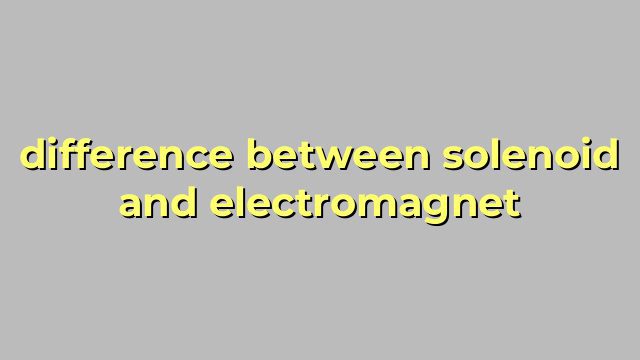The Difference Between Solenoid and Electromagnet
If you’ve ever studied electricity, you may have come across two terms that seem similar: solenoid and electromagnet. While they both involve the use of an electric current to create a magnetic field, there are some key differences between the two.
Solenoid
A solenoid is an electromechanical device that converts electrical energy into mechanical energy. It consists of a coil of wire wrapped around a cylindrical core, usually made of iron or steel. When a current flows through the coil, it creates a magnetic field that attracts a movable plunger or rod, causing it to move back and forth within the solenoid.
Solenoids are commonly used in various applications, including locks, valves, and starter motors. For example, when you turn the key in your car’s ignition, the starter solenoid receives an electrical signal, which activates the plunger and engages the starter motor to crank the engine.
Electromagnet
An electromagnet, on the other hand, is simply a coil of wire that produces a magnetic field when an electric current flows through it. Unlike a solenoid, it doesn’t have a moveable element, and its purpose is purely to create a magnetic field for various applications.
Electromagnets are used in a wide range of industrial and scientific applications, such as magnetic levitation trains, MRI machines, and electric generators. They are also used in everyday devices, such as speakers and televisions.
The Key Differences
The main difference between a solenoid and an electromagnet is that a solenoid is an electromechanical device, while an electromagnet is purely an electrical device. In other words, a solenoid converts electrical energy into mechanical energy, whereas an electromagnet simply creates a magnetic field.
Additionally, a solenoid has a moveable element, such as a plunger or rod, which is controlled by the magnetic field it produces. An electromagnet, on the other hand, doesn’t have a moveable element and is typically used in applications where a magnetic field is required.
In summary, while solenoids and electromagnets both involve the use of an electric current to create a magnetic field, they are different in their design and application. Understanding the differences between the two can help you choose the right type of device for your specific needs.
Table difference between solenoid and electromagnet
| Parameter | Solenoid | Electromagnet |
|---|---|---|
| Definition | A coil of wire that produces a magnetic field when current is passed through it | A type of magnet in which the magnetic field is produced by an electric current |
| Function | Converts electrical energy into mechanical energy or linear motion | Converts electrical energy into a magnetic field |
| Size | Generally larger | Generally smaller |
| Application | Used in a variety of industrial and automotive applications such as door locks, pneumatic valves, and conveyor belts | Used in a variety of electronic devices such as speakers, generators, and hard drives |
| Core Material | Typically, the core material is ferromagnetic | Typically, the core material is soft iron |
| Magnetic Field | Produces a strong, uniform magnetic field along its axis | Produces a weaker magnetic field than a solenoid, but can be turned on and off rapidly |


